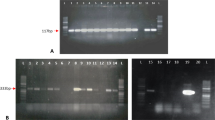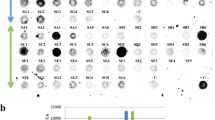Abstract
The structure of an insect control protein gene from Bacillus thuringiensis var. kurstaki HD–1 was determined, and truncated forms of the gene that express a functional insecticidal protein were generated. Two of these truncated genes were incorporated into a plant expression vector for Agrobacterium–mediated transformation. Transgenic tomato plants containing the chimeric genes express the insect control protein gene. Such expression confers tolerance to lepidopteran larvae on the transgenic tomato plants and their progeny. These engineered tomato plants represent a significant step to increased selectivity, specificity and efficiency in insect control.
This is a preview of subscription content, access via your institution
Access options
Subscribe to this journal
Receive 12 print issues and online access
$209.00 per year
only $17.42 per issue
Buy this article
- Purchase on Springer Link
- Instant access to full article PDF
Prices may be subject to local taxes which are calculated during checkout
Similar content being viewed by others
References
Dulmage, H.T. 1981. Insecticidal activity of isolates of Bacillus thuringiensis and their potential for pest control, p. 193–222. In: Microbial Control of Pests and Plant Diseases 1970-1980. H. D. Burges (ed.). Academic Press, New York.
Angus, T.A. 1954. A bacterial toxin paralysing silkworm larvae. Nature 173: 545–546.
Wilcox, D.R., Shivakuma, A.G., Melin, B.E., Miller, M.F., Benson, T.A., Schopp, C.W., Casuto, D., Gundling, G.J., Boiling, T.J., Spear, B.B. and Fox, J.L. 1986. Genetic engineering of bioinsecticides, p. 395–413. In: Protein Engineering. M. Inouye and R. Sarma (eds.). Academic Press, New York.
Bulla, L.A., Kramer, K.J. and Davidson, L.I. 1977. Characterization of the entomocidal parasporal crystal of Bacillus thuringiensis . J. Bacteriol. 130: 375–383.
Schnepf, H.E., Wong, H.C. and Whiteley, H.R. 1985. The amino acid sequence of a crystal protein from Bacillus thuringiensis deduced from the DNA base sequence. J. Biol. Chem. 260: 6264–6272.
Shibano, Y., Yamagata, A., Nakamura, N., lizuka, T., Sugisaki, H. and Takanami, M. 1985. Nucleotide sequence coding for the insecticidal fragment of the Bacillus thuringiensis crystal protein. Gene 34: 243–251.
Adang, M.J., Staver, M.J., Rochleau, T.A., Leighton, J., Barker, R.F. and Thompson, D.V. 1985. Characterized full length and truncated plasmid clones of the crystal protein of Bacillus thuringiensis subsp. kurstaki HD73 and their toxicity to Manduca sexta . Gene 36: 289–300.
Thorne, L., Garduno, F., Thompson, T., Decker, D., Zounes, M., Wild, M., Walfield, A.M. and Pollock, T.J. 1986. Structural similarity between the Lepidoptera and Diptera specific insecticidal endotoxin genes of Bacillus thuringiensis subsp. kurstaki and israelensis . J. Bacteriol. 166: 801–811.
Wabiko, H., Raymond, K.C. and Bulla, L.A. 1986. Bacillus thuringiensis entomocidal protoxin gene sequence and gene product analysis. DNA 5: 305–314.
Hofte, H., de Greve, H., Seurinck, J., Jansens, S., Mahillon, J., Ampe, C., Vandekerckhove, J., Vanderbruggen, H., van Montagu, M., Zabeau, M. and Vaeck, M. 1986. Structural and functional analysis of a cloned delta endotoxin of Bacillus thuringiensis berliner 1715. Eur. J. Biochem. 161: 273–280.
Geiser, M., Schweitzer, S. and Grimm, C. 1986. The hypervariable region in the genes coding for entomopathogenic crystal proteins of Bacillus thuringiensis: Nucleotide sequence of the kurhd1 gene of subsp. kurstaki HD1. Gene 48: 109–118.
Fraley, R.T., Rogers, S.G. and Horsch, R.B. 1986. Genetic transformation in higher plants. Critical Reviews in Plant Sciences. 4: 1–46.
Shah, D.M., Horsch, R.B., Klee, H.J., Kishore, G.M., Winter, J.A., Turner, N.E., Hironaka, C.M., Sanders, P.R., Gasser, C.S., Aykent, S., Siegel, N.R., Rogers, S.G. and Fraley, R.T. 1986. Engineering herbicide tolerance in plants. Science 233: 478–481.
Comai, L., Facciotti, D., Hiatt, W.R., Thompson, G., Rose, R.E. and Stalker, D.M. 1985. Expression in plants of a mutant aroA gene from Salmonella typhimurium confers tolerance to glyphosate. Nature 317: 741–744.
Powell Abel, P., Nelson, R.S., De, B., Hoffmann, N., Rogers, S.G., Fraley, R.T. and Beachy, R.N. 1986. Delay of disease development in transgenic plants that express the tobacco mosaic virus coat protein gene. Science 232: 738–743.
Watrud, L.S., Perlak, E.J., Tran, M.-T., Kusano, K., Mayer, E.J., Miller-Wideman, M.A., Obukowicz, M.G., Nelson, D.R., Kreitinger, J.P. and Kaufman, R.J. 1985. Cloning of the Bacillus thuringiensis subsp. kurstaki delta endotoxin gene into Pseudomonas fluorescens: Molecular biology and ecology of an engineered microbial pesticide, p. 40–46. In: Engineered Organisms in the Environment. H. O. Halvor-son, D. Pramer and M. Rogul (eds.). American Society for Microbiology, Washington.
Obukowicz, M.G., Perlak, E.J., Kusano-Kretzmer, K., Mayer, E.J. and Watrud, L.S. 1986. Integration of the delta endotoxin gene of Bacillus thuringiensis into the chromosome of root colonizing strains of pseudomonads using Tn5 . Gene 45: 327–331.
Bulla, L.A., Kramer, K.J., Cox, D.J., Jones, B.L., Davidson, L.I. and Lookhart, G.L. 1981. Purification and characterization of the entomocidal protoxin of Bacillus thuringiensis . J. Biol. Chem. 256: 3000–3004.
Nagamatsu, Y., Itai, Y., Hatanaka, C., Funatsu, G. and Hayashi, K. 1984. A toxic fragment from the entomocidal crystal protein of Bacillus thuringiensis . Agric. Biol. Chem. 48: 611–619.
Schnepf, H.E. and Whiteley, H.R. 1985. Delineation of a toxin encoding segment of a Bacillus thuringiensis crystal protein gene. J. Biol. Chem. 260: 6273–6280.
Sanders, P.R., Winter, J.A., Barnason, A.R., Rogers, S.G. and Fraley, R.T. 1987. Comparison of cauliflower mosaic virus 35S and nopaline synthase promoters in transgenic plants. Nucleic Acids Res. 15: 1543–1558.
Fraley, R.T., Rogers, S.G., Horsch, R.B., Eichholtz, D.A., Flick, J.S., Fink, C.L., Hoffmann, N.L. and Sanders, P.R. 1985. The SEV system: A new disarmed Ti plasmid vector system for plant transformation. Bio/Technology 3: 629–635.
McCormick, S.M., Niedermeyer, J., Fry, J., Barnason, A., Horsch, R. and Fraley, R. 1986. Leaf-disc transformation of cultivated tomato (L. esculentum) using Agrobacterium tumefaciens . Plant Cell Reports 5: 81–84.
Odell, J.T., Nagy, F. and Chua, N.-H. 1985. Identification of DNA sequences required for activity of the cauliflower mosaic virus 35S promoter. Nature 313: 810–812.
Bevan, M., Barnes, W.M. and Chilton, M.-D. 1983. Structure and transcription of the nopaline synthase gene region of T-DNA. Nucleic Acids Res. 11: 369–385.
Luthy, P. and Ebersold, H.R. 1981. Bacillus thuringiensis delta endotoxin: Histopathology and molecular mode of action, p. 235–267. In: Pathogenesis of Invertebrate Microbial Diseases. E.W. Davidson (ed.). Allanheld, Toronto.
Davidson, R.H. and Lyon, W.F. 1987. Insect Pests of Farm, Garden and Orchard, Wiley & Sons, New York.
Jones, J.D.G., Dunsmuir, P. and Bedbrook, J. 1985. High level expression of introduced chimaeric genes in regenerated transformed plants. EMBO J. 4: 2411–2418.
Maniatis, T., Fritsch, E.F. and Sambrook, J. 1982. Molecular Cloning, A Laboratory Manual, Cold Spring Harbor Laboratory, Cold Spring Harbor, New York.
Sanger, F., Nicklen, S. and Coulson, A.R. 1977. DNA sequencing with chain-terminating inhibitors. Proc. Nat. Acad. Sci. USA 74: 5463–5467.
Biggin, M.D., Gibson, T.J. and Hong, G.F. 1983. Buffer gradient gels and 35S label as an aid to rapid DNA sequence determination. Proc. Nat. Acad. Sci. USA 80: 3963–3965.
Messing, J. and Viera, J. 1982. A new pair of M13 vectors for selecting either DNA strand of double-digest restriction fragments. Gene 19: 269–276.
Zoller, M.J. and Smith, M. 1982. Oligonucleotide-directed mutagene-sis using M13-derived vectors: An efficient and general procedure for the production of point mutations in any fragment of DNA. Nucleic Acids Res. 10: 6487–6500.
Rochester, D.E., Winter, J.A. and Shah, D.M. 1986. The structure and expression of maize genes encoding the major heat shock protein hsp70. EMBO J. 5: 451–458.
Abbott, W.S. 1925. A method of computing the effectiveness of an insecticide. J. Econorn. Entomol. 18: 265–267.
Author information
Authors and Affiliations
Rights and permissions
About this article
Cite this article
Fischhoff, D., Bowdish, K., Perlak, F. et al. Insect Tolerant Transgenic Tomato Plants. Nat Biotechnol 5, 807–813 (1987). https://doi.org/10.1038/nbt0887-807
Received:
Accepted:
Issue Date:
DOI: https://doi.org/10.1038/nbt0887-807
This article is cited by
-
Host plant resistance for fall armyworm management in maize: relevance, status and prospects in Africa and Asia
Theoretical and Applied Genetics (2022)
-
Molecular genetic approaches for enhancing stress tolerance and fruit quality of tomato
Plant Biotechnology Reports (2020)
-
Cry1Ac-mediated resistance to tomato leaf miner (Tuta absoluta) in tomato
Plant Cell, Tissue and Organ Culture (PCTOC) (2017)



